If there’s one word to describe backpackers, it’s “dirty.” Eighteen-hour bus rides in sweltering summer heat with no air conditioning is just a recipe for olfactory disaster, making laundry errands a frequent necessity for staying socially presentable in far-away lands.
For extended trips, this can become a hassle, as certain hotels and laundromats might charge pricey fees, or have awkward closing times and three-day weekends.
The alternative is the sink or shower wash, which is free, but takes up potentially valuable time and effort, and never gets your clothing as clean as you might like.
Or you could just do what most backpackers do, and wear dirty clothes half the time.

Laundry concerns are an even bigger deal for anyone trying to pack as little as possible (like me). I consider minimizing pack size to be extraordinarily helpful, but the downside is that you’ll be doing laundry far more frequently than someone with a giant monster backpack.
Often I wonder if I’m the only one having crazy concerns like these, as everyone else seems content with the expensive-laundry-status-quo, but it was nice to see a solution to this predicament, in the form of a manual washing machine you can take with you wherever you go.
The Scrubba: A portable, pocket-sized, manual washing machine
The recently designed Scrubba attempts to solve the hostel sink hand-wash ickiness or expensive hotel laundry service problems by giving you your very own hand-powered washing machine, allowing you to get your clothes squeaky clean in just a few minutes.
I was looking forward to trying this out, as I like the option of being able to wash my clothes as needed, whether it’s due to pricey fees or getting stuck somewhere with no laundry facilities.
It’s currently $55, plus shipping costs, and is ultra-portable, scrunching down to the size of a t-shirt, and weighing about 5 ounces (~140 g).
Here’s how tiny it is:
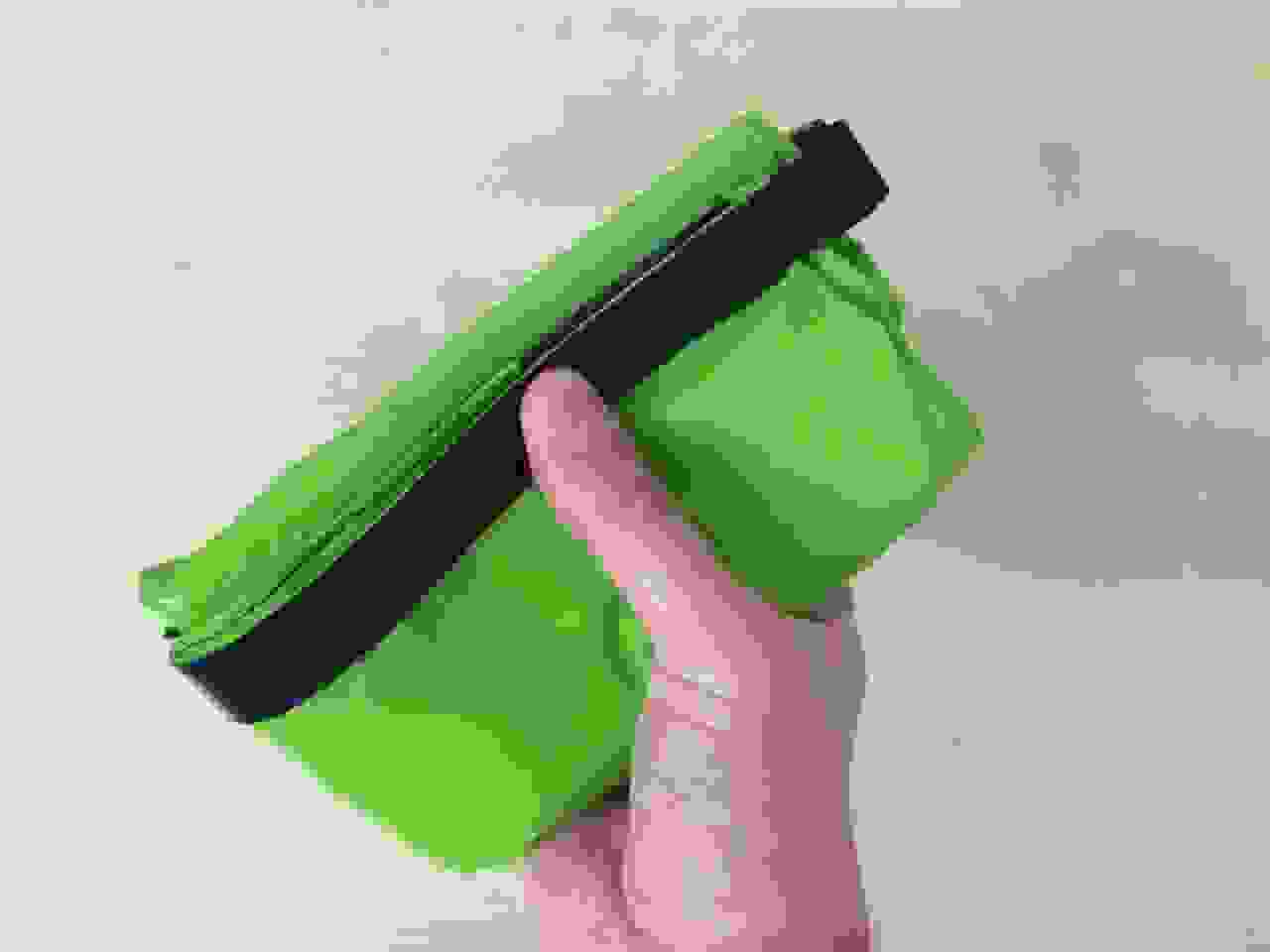
When unfurled, it looks very much like a typical waterproof roll-top dry bag (because that’s what it is), except with the additions of a see-through window, an air release valve, maximum fill lines, and printed instructions.
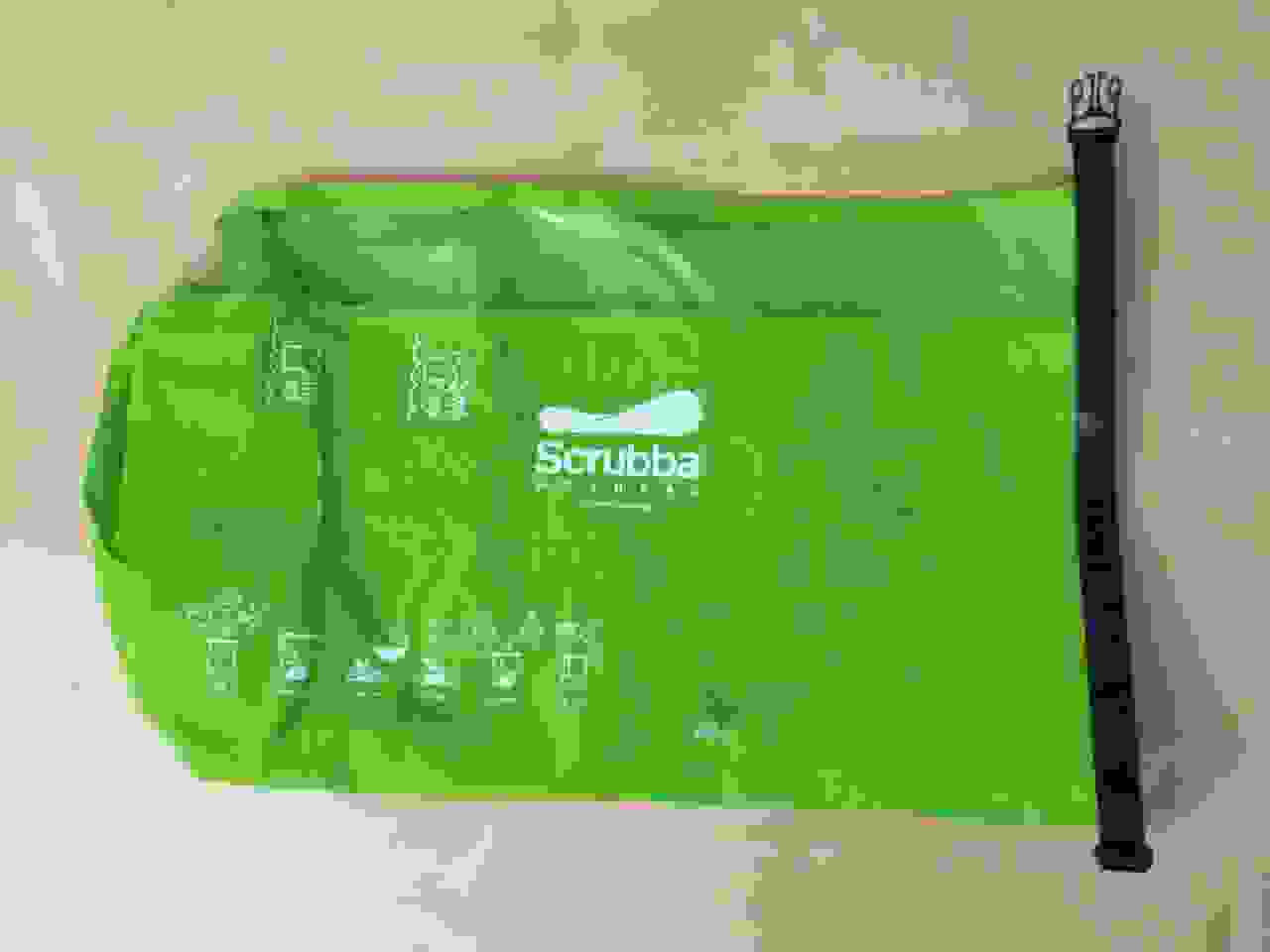
But it’s the inside that’s most significant, as it features a series of rubbery protrusions that act like a washboard. You know, those things people used to hand-wash their clothes before we had machines to do it for us?
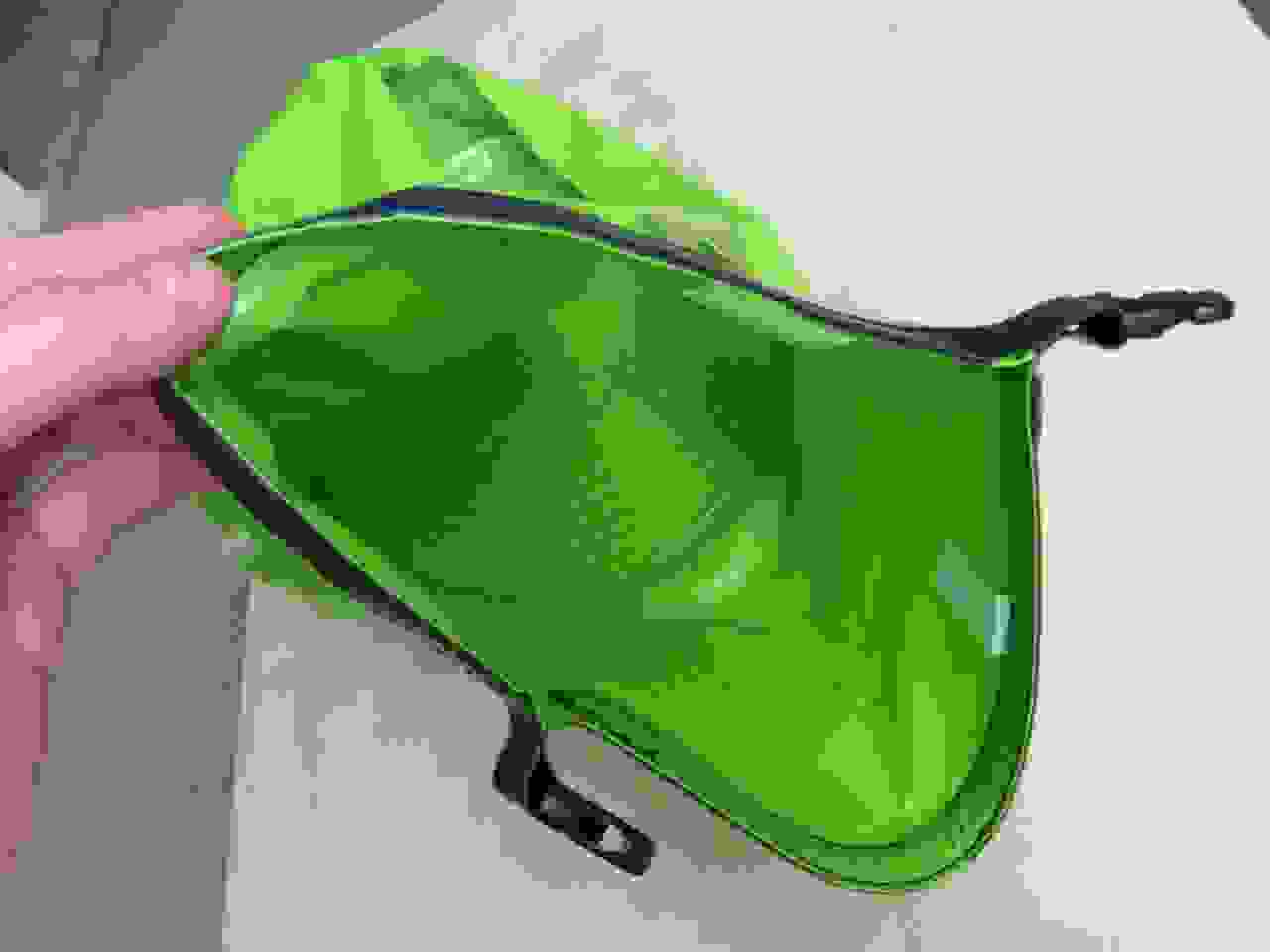
These little bumps significantly increase the agitation and cleaning ability, making it far more efficient and effective than just swirling a t-shirt around in the sink, or holding one up in front of a shower head for a while. With this thing you’re actually scrubbing your clothes, rather than just rinsing them off a bit.
Here’s how it works:
The Scrubba in action
The process is quite simple, and, as mentioned, it has wordless instructions printed right on the outside, so you don’t have to worry about losing an instruction manual.
Step 1: Fill it up
Clothing, soap, and water:
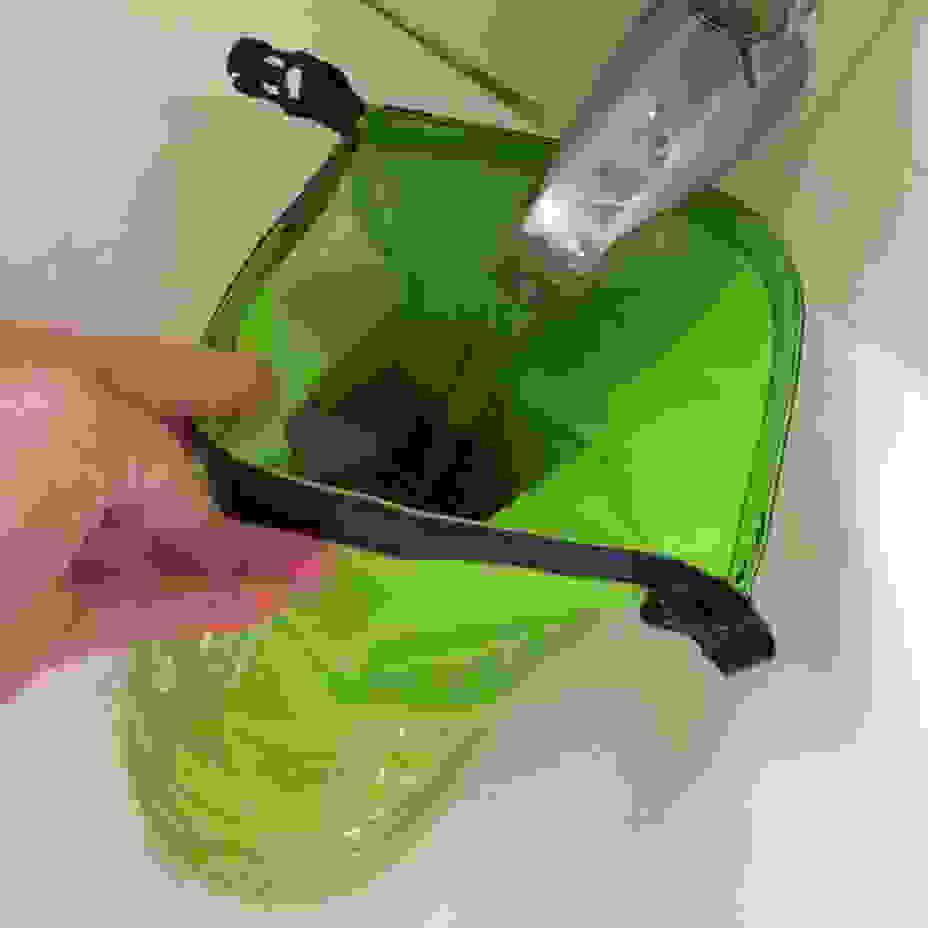
It can handle one set of clothes at a time, or two sets if you’re not washing pants.
By the way, zip up any metal zippers. They have sharp teeth that can bite into things. This is a good idea when using any laundry machine, but even more important here, as you’re shoving clothes against each other (and against the bag) in a vigorous manner.
Scrubba claims you only need a few drops of concentrated soap, as the scrubbing action is handling a lot of the cleaning process. If you think about how much laundry soap you add to a full-size washing machine, you can imagine how little you’d need for just a set or two of clothes.
Step 2: Roll and clip
I usually roll it down pretty far to be safe.
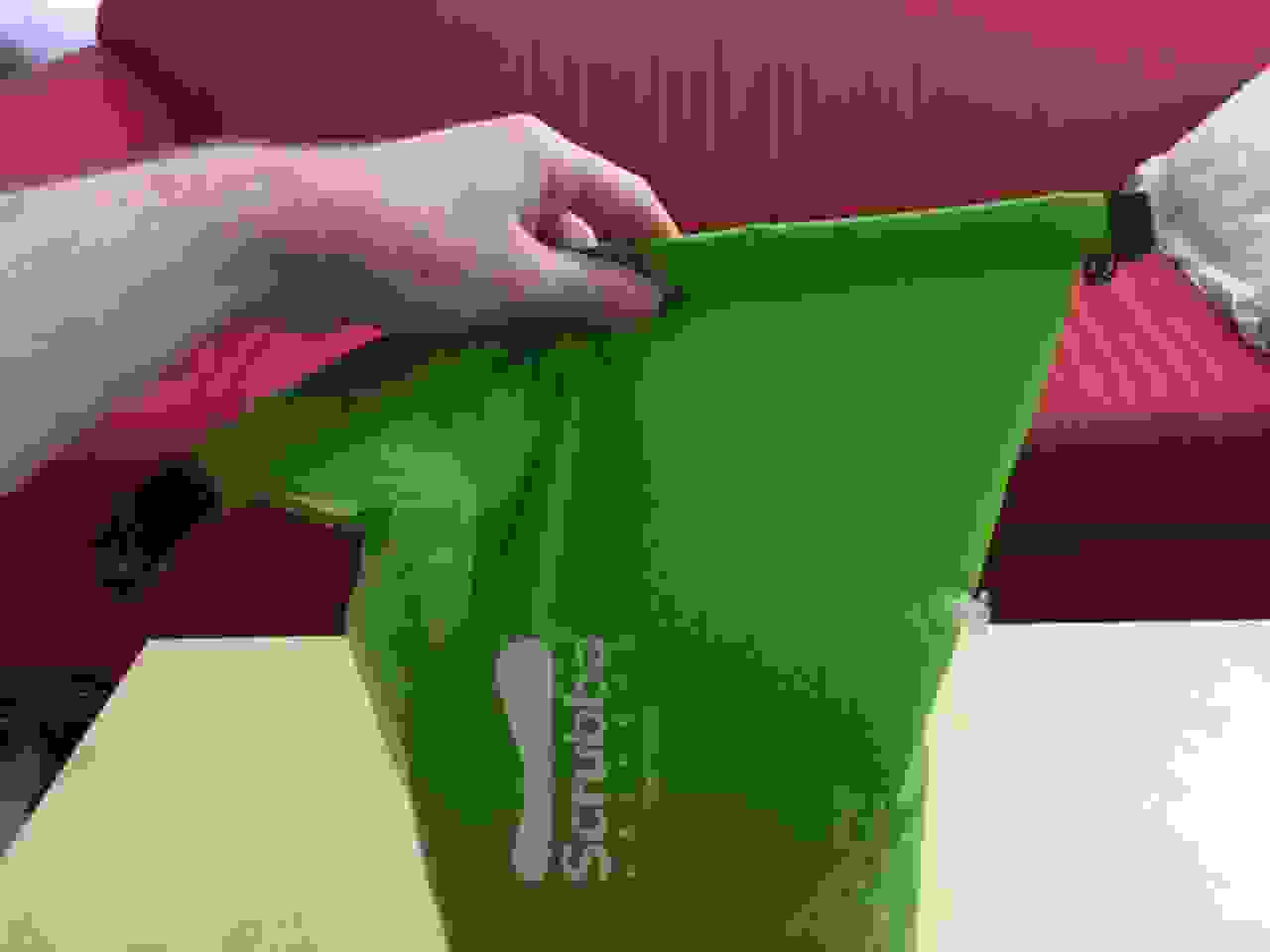
And clip:
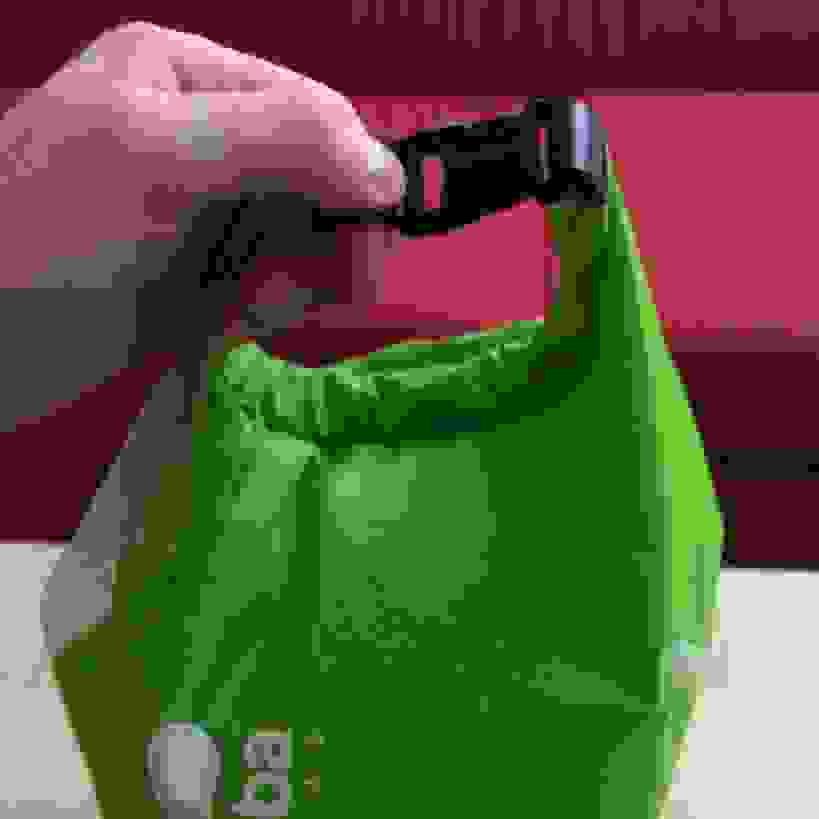
Step 3: Deflate
This removes the excess air, which will allow you to scrub against the washboard more effectively:
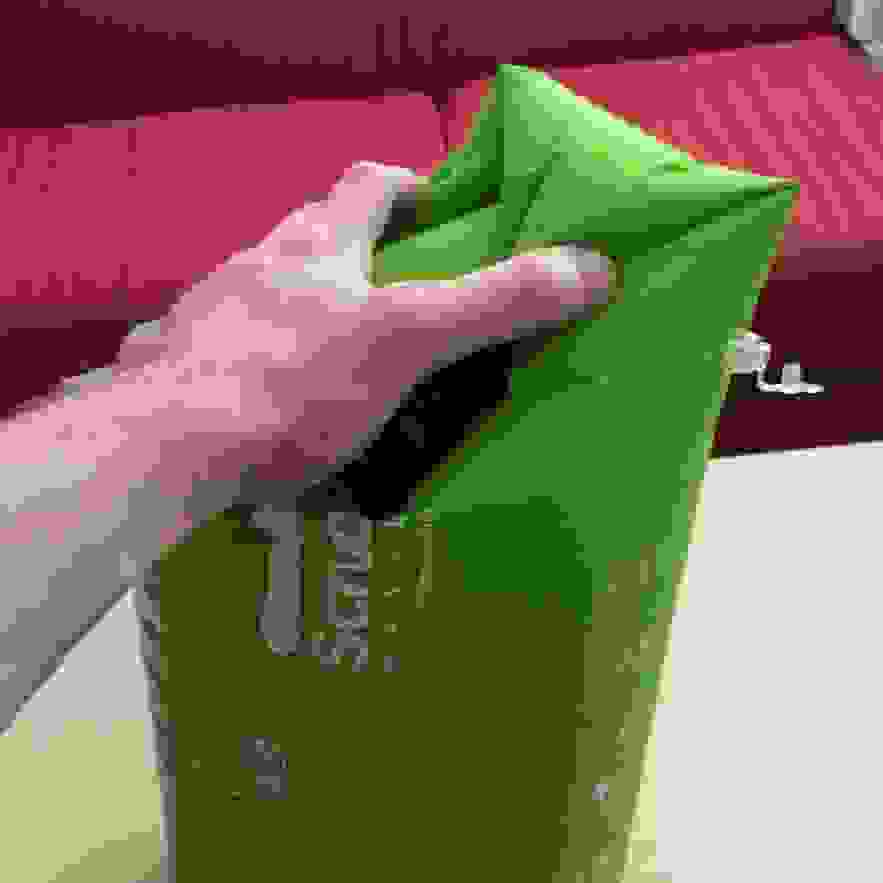
By the way, that pressure release valve is very secure; you actually need to pinch it to allow air to escape (which I wasn’t doing in the photo, due to a lack of hands), so it won’t just leak on its own, even if it’s open.
Step 4: Scrub
You can really feel those ridges in the base of the bag hitting the clothes while you’re washing. The outside of the bag also has a sticky base to hold it in place on a countertop, which is quite helpful during vigorous scrubs.
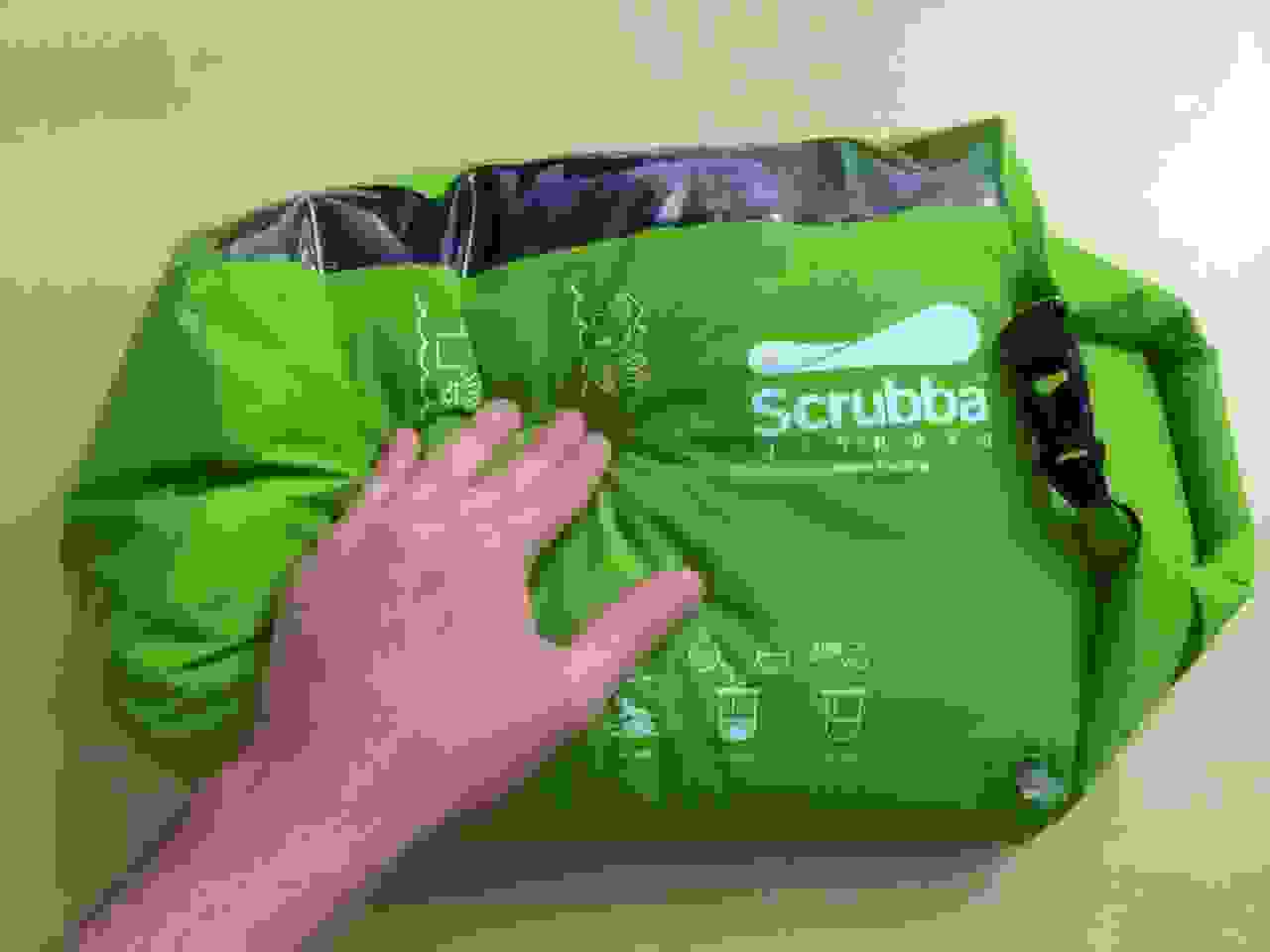
Scrubba recommends washing anywhere from 30 seconds to 3 minutes, depending on how icky your clothes were to begin with. You could alternatively do two quick wash cycles instead of one big one.
Step 5: Drain and rinse
Emptying this thing out is actually the trickiest part of the procedure, as you’ll need to dump the water out, but keep the clothes inside. I found the “upside-down strangle” method to be the most effective:
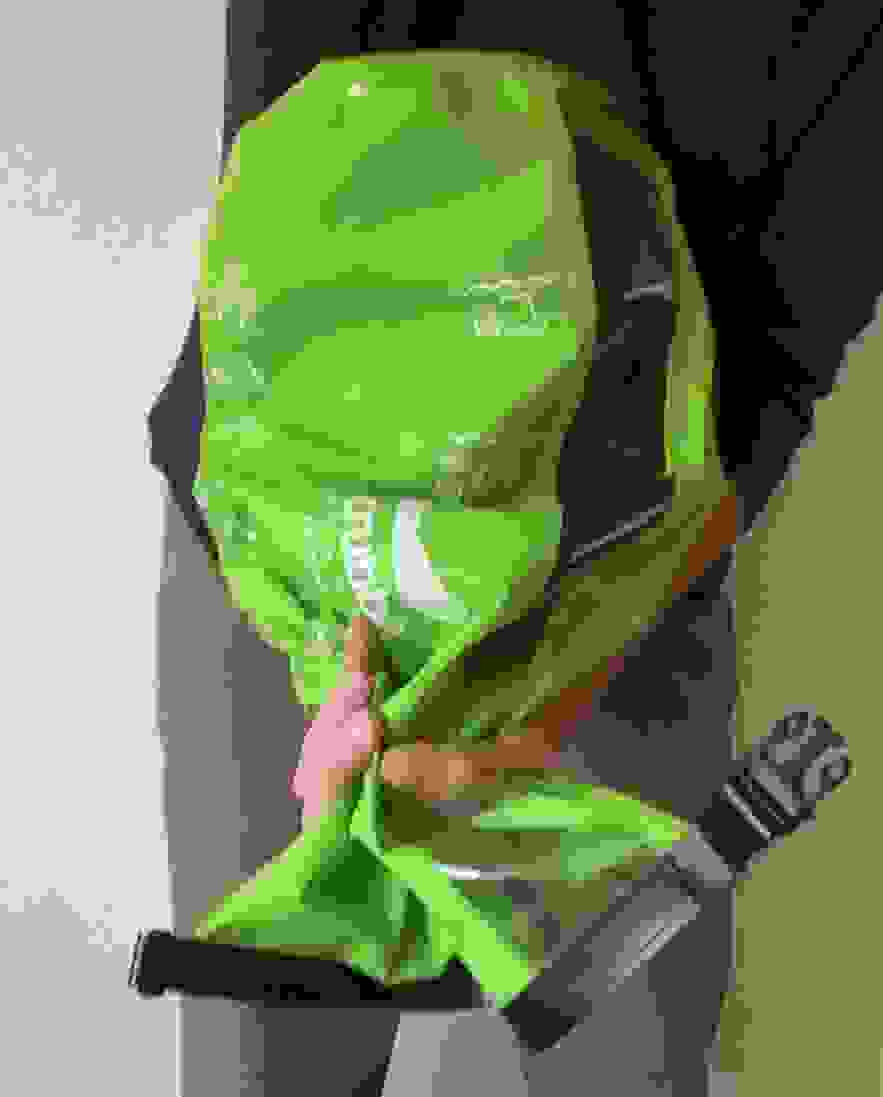
This drains the water through the clothes, so the clothes will catch some of the dirt you’re trying to clean, but that’s what rinse cycles are for. After you refill for the rinse, you can just pull the clothes out from the top, without draining the bag, and wring them out over a sink or shower drain.
Toweling off the inside of the bag will help it dry faster, which is important for mold prevention. You’ll also want to make sure it’s wide open for air-drying, or inside-out.
Step 6: Wring, towel dry and hang
If you’re not familiar with hand washing, you’ll want to wring out as much water from the clothes as you can, but not enough to damage them. I’ve mangled a few t-shirts this way, which is why I prefer the squish method rather than the twist method, though a little twisting is fine.
The towel roll isn’t strictly necessary, but it can cut drying time in half, and will eliminate drips. It’s generally a good idea in colder climates, and also if you have nowhere to hang them but in the shade.
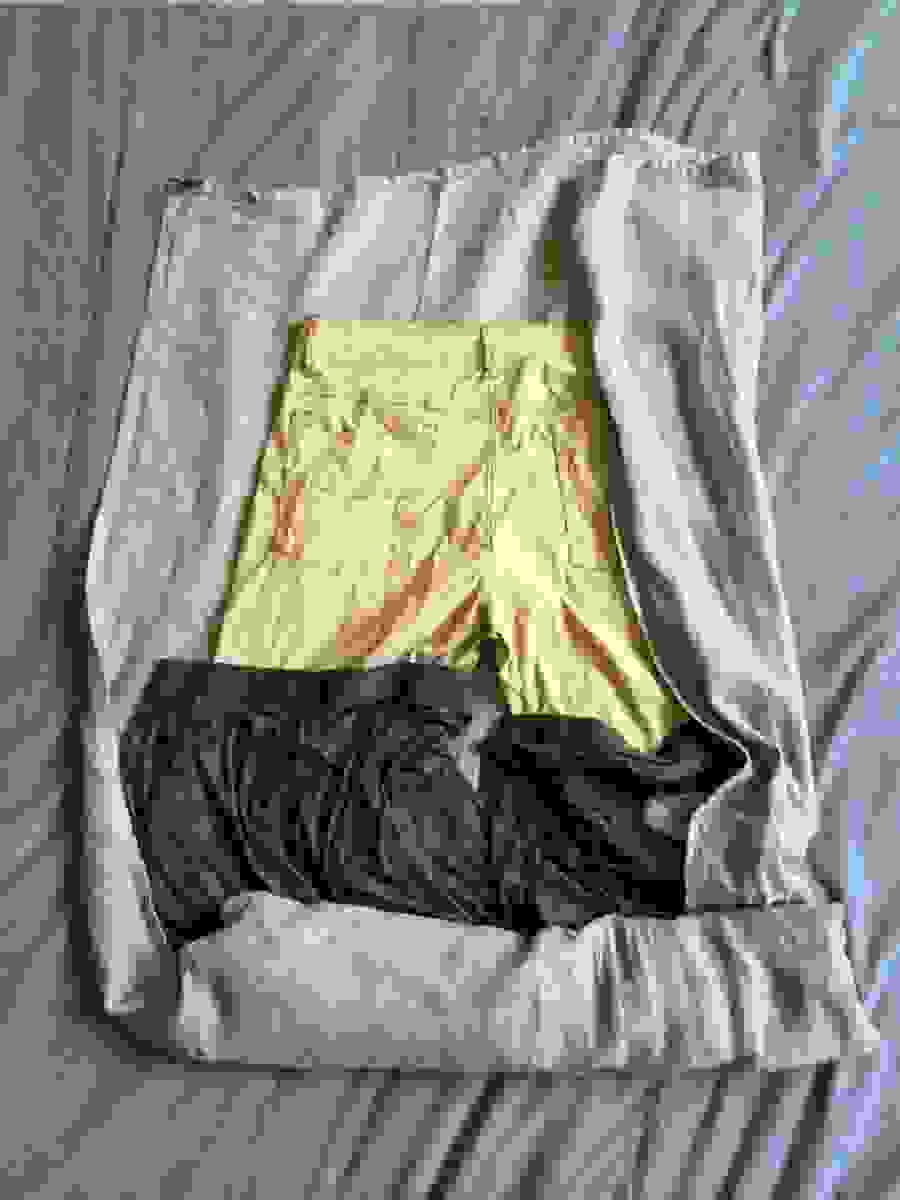
And, finally, hang up the clothes, and you’re done for now.
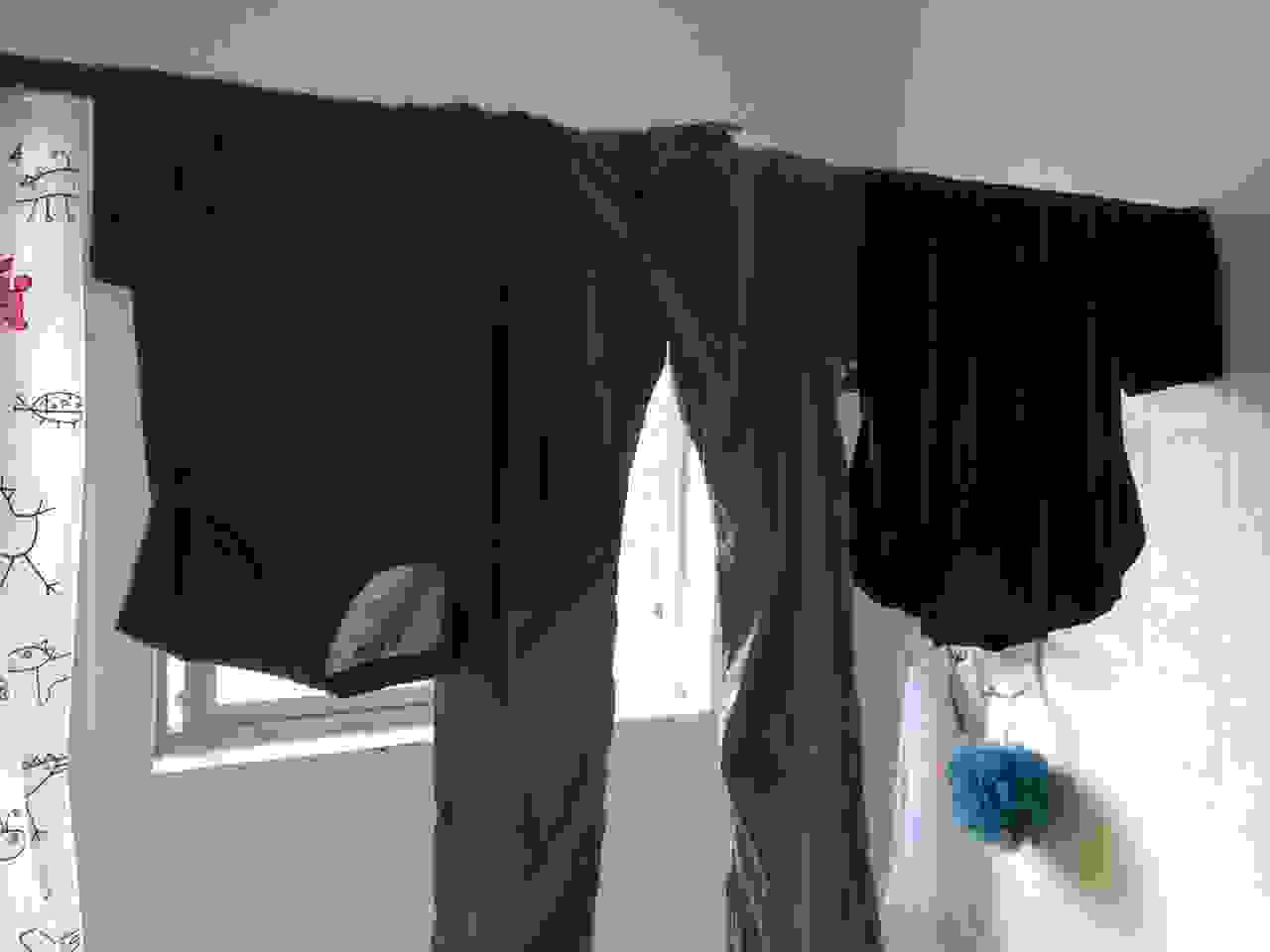
It can take anywhere from 6-36 hours for clothes to dry, depending on how well they were wrung out and towel-dried, how sunny it is, the thickness of the fabric, and so on. It’s good to know more or less how long it’ll take your clothes to dry, so you can plan on doing laundry when you have time for them to dry completely.
Dorky analysis
I have always found constant laundry errands to be a huge nuisance, and I was dreaming of some sort of magical contraption that would reduce the time-consuming process down to a ridiculously quick procedure that I’d only have to do every few days, but I don’t think that’s actually possible.
While it’s true that you only need a few minutes to wash your clothes with the Scrubba, it won’t speed up the wringing, towel rolling, and hang drying steps, so the grand total amount of time might not be significantly reduced. And although it’s true that you can wash several items simultaneously instead of dealing with them one at a time, that saved time is offset by filling, clipping, deflating, and emptying the bag.
By comparison, if you’re doing a sink wash, you can start scrubbing clothes while the sink is filling up, and start wringing them out as the sink is draining, whereas the Scrubba requires you to do those steps separately. And although a shower wash pretty much requires you to wash your clothes one at a time, it doesn’t require any time spent filling and draining a bag, and you’re also (sort of) getting a shower at the same time.
The Scrubba also requires a flat surface for scrubbing, and if there isn’t one in the bathroom, you might find yourself using the floor, or wandering around in search of a table.
But, all that said, it definitely seems to get the clothes a lot cleaner. Sink washing is sort of a swish-around-in-the-water sort of process, as it’s hard to scrub vigorously when it’ll get water everywhere. Shower washing is better for splash prevention, but even with vigorous scrubs, it doesn’t feel like it’s doing much more than a basic rinse.
In contrast, the Scrubba allows you to scrub the hell out of your clothes, getting them as clean as you want, which is a major improvement compared to sink and shower washes. So it won’t necessarily increase the speed of a hand wash, but it’ll definitely increase the quality. And for some people, that might be exactly what they need.
Thus:
Scrubba review conclusions
Good things:
- The Scrubba allows you to hand-wash your clothes anywhere, anytime, as long as you’ve got soap and water, in just a few minutes.
- It’s lightweight, and packs down small.
- It’ll get your clothes a lot cleaner than a sink or shower wash.
- You can do your laundry for free.
- It doubles as a waterproof dry bag.
Potential issues:
- Manual laundry is still going to be a time-consuming process.
- $55 will be a little pricey for some people.
- It’s possible to make your own for maybe half the price, by using a regular dry bag and adding the ridges yourself with some sort of rubbery glue-like substance (though in that case you won’t get the see-through section or the deflation valve).
This is definitely a mix of pros and cons, which will work nicely in certain situations, but might not be quite as helpful in others. Thus:
It’s good for:
- Backpacking through expensive countries, where laundry fees might get annoyingly pricey, especially on longer trips.
- Rural areas that have no laundry facilities at all.
- Washing just one or two items at a time, especially if you need a specific outfit for some reason.
- Road trips or camping trips, where there might not be a laundry machine for miles.
If laundry services cost $5 per load, you’ll start saving money after skipping a dozen laundry cycles, and it certainly won’t stop you from enjoying free laundry services if they happen to be available. I would expect it would therefore be most effective for trips of several months or more, in summer heat, through countries with high laundry prices, where you plan on hand washing to save cash. Backpacking Western Europe in the heat of summer, for example.
But not so good for:
- Traveling through super-cheap countries with readily-available laundry facilities.
- Short trips where you won’t do laundry anyway (duh).
- People who would rather just pay for laundry.
But even in those cases, it might come in handy if all the laundromats are closed for the day, or if you spill coffee all over yourself and need that shirt clean by tomorrow morning.
So I think it’s definitely worth a look for those ultralight backpackers who want a manual washing method that’s more effective than a quick soak in the sink, and it’ll definitely fulfill that requirement. Whether it’s cost-effective or not will depend on the length of the trip, how pricey the country is, and how often you make use of it.
I expect that some people will swear by it, as it can be incredibly useful for certain types of trips, where a pocket-sized, hand-powered washing machine would see constant use, and save lots of money. If that sounds like you, you’ll probably love it.
You can pick it up here.
Update! After a trip through Central America where I used this to wash my clothes, pretty much all the analysis above has been confirmed. You can clean your clothes better, but not faster, than with a shower wash. I would recommend only doing one set of clothes at a time, though if you’re not washing pants, then you can do two. Otherwise it just seems to get too big and you can’t scrub that well. Also, to speed things up, just use more soap, rather than spending more time scrubbing. You’ll tire yourself out after the first 30 seconds, and the scrub will get less and less vigorous thereafter. So just use a bit more soap, and rinse thoroughly.




It’s an interesting concept, and I’m going to Pin it in case I get a few extra bucks to blow before my next trip. I’ve been doing my laundry when I take my shower, using shampoo. Splashing and rinsing takes place while I splash and rinse myself. I also take six clothespins and a length of twine when I travel, which makes it easier to hang clothes to dry. I’m female, and enjoy your blog–will add it to bloglovin.com! I do travel with 3 pairs of shoes, just in case I get to go out somewhere “classy”.
Yes, the ladies seem to agree that a trio of shoes are needed; walking, clubbing, and flip-flopping. Basically. It’s not so bad though. Usually women’s shoes are smaller than men’s shoes, and although I’m not really an expert on this, I think the things known as “ballet flats” are the ultralight answer to a fancy pair of shoes for a night out (though not necessarily super comfy, but I’m sure some can be).
Not to belabor the point, but the reasoning behind the 3 shoes for ladies is simple. Flip-flops are great for icky showers, lounging around, and they can be worn at the beach or for walking. The heels have to be there for going out, dancing, flirting, or somewhere classy. Heels can be a signal that you might be available for romance. Anyway, the flip-flops are flat! You wouldn’t want to take TWO pair of flat shoes. LOL
i got this for my last trip and the little handle on the air release valve broke off and it’s already starting to leak water. Only used 3-5 times and it broke, what a waste of money. Customer service has been most unhelpful as well.
That is unfortunate. And now public knowledge, too…
I’ve been thinking of getting the Scrubba, but some people on Amazon seem to be concluding that 1) it’s very difficult to get the air to release out of the valve, and 2) the valve is poorly made and prone to failing in some fashion. What was your experience? Sometimes I think people just get frustrated and don’t take the time to learn how to do something, and wonder if that’s the case here. Or, maybe this is an aspect of the Scrubba that needs to be improved in its next incarnation.
1) The valve has two entirely separate sealing mechanisms; first, the plug, which you obviously have to unplug; secondly, the valve itself is actually squished shut while at rest, so you have to pinch it, and you will then hear the air coming right out. I think the people having trouble just aren’t pinching, because they don’t realize they need to. It’s a safety mechanism to keep it from leaking, even when the plug isn’t plugged in. But it’s quite easy to operate, once you know you have to squish the bag AND pinch the open valve to deflate.
2) I actually think the plug is very strong, and in fact is hard to get open sometimes. I would have added some larger, gripper sort of thing so it could be easier to open, especially with wet hands. The tiny handle is just not big enough to grip properly when the plug is stuck tightly in the valve. But that’s the only operability issue I’ve had.
Thanks for the detailed and very specific reply. I think I’ll give the Scrubba a try.
What fabric is the scrubba made out of and is it as hardy as most other dry bags?
It’s the same as any other dry bag material. It feels very solid to me, even if you’re giving it a really tough scrub.
I have been using a Scrubba to do laundry on a sailboat for a few years now. Once you learn what the limits are for how much to put in, how much soap to use, how to handle rinses, etc… it uses very little water for the quality of wash you get vs. a sink. I have washed hundreds of t-shirts, socks, underwear, and other soft not too bulky items with no damage to the bag. One of the nice things is that if you have a floor (or boat deck) that can get wet is that you can put everything in there and then sit back with a foot on the bag and scrub away for a few minutes while having a cold one…
I wouldn’t have thought of using my feet, but that’s a great idea.
I know I’m super late to the convo however…
I bet if you used a dry bag and put a deflated (or not) child’s bumpy ball in there, that would do the trick. You can get them anywhere in lots of different sizes.
Yeah, I’ve heard of people using a regular dry bag and adding their own internal dots using one of those phone charger repair rubbery cement sorts of things. That’s why I’m a little iffy on it, and dunking things under a faucet for a while works pretty well too.
Very late for this discussion, but I’ve had about three years experience with the Scrubba now across half a dozen multi-week trips (China, India, Japan, South East Asia, south eastern Europe), and I’m a big fan. It takes up no space, gets clothes clean, and has proved durable. The exception is the valve which I have always found fiddly; I worked around this by simply keeping it shut all the time and expelling the air as you would with a dry bag. The Scrubba team apparently have responded to the valve issues with a new one in any case.